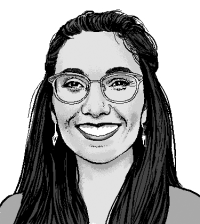Sharing the burden of language disorientation
At my church, some of us are learning Spanish. Others are learning English.

(Source image by Just_Super / E+ / Getty)
I practiced the word over and over, a vosotros form of beber that looms over the Spanish version of the words of institution. Despite my preparation, when I hold up the cup I stumble over this form, rarely used in Spanish conversation: “Haced esto todas las veces que la bebáis.” Laura smiles at me, a shared look of amusement and compassion. She is learning English as I am relearning Spanish, and in our church, we gently hold each other in this tenuous and sometimes embarrassing world of language learning.
We are knitting together a congregation of Spanish and English speakers, weaving the experiences of migrants and refugees, people who came to this country with money and jobs and others who came with nothing. Other Spanish speakers in our congregation learned the language through diligent study, led by curiosity and solidarity.
Read our latest issue or browse back issues.
By 2045, the people in my congregation who trace their ancestry to Mexico, Argentina, and Colombia, along with those whose heritage is multiracial and multiethnic, will represent the largest population in the United States. Language diversity accompanies this racial and ethnic diversity. Our church now includes people who grew up in homes speaking Russian, Mandarin, Swedish, and Spanish—languages that held the tenderness of their parents’ care and in which they heard the stories of our common faith.
I’ve read the accounts of first-generation immigrants describing language assimilation and the loss of their native tongue. A headline on a student news site evocatively describes this process as “the sound of crumbling roots.” Writer Jenny Liao explains the disorientation of language loss and the painful separation this brought to her relationship with her Cantonese-speaking parents. “No one prepared me for the heartbreak of losing my first language,” she writes in the New Yorker. “It doesn’t feel like the sudden, sharp pain of losing someone you love, but rather a dull ache that builds slowly until it becomes a part of you.”
I’m aware that our Spanish-speaking church members have a desire—a need—to learn English in order to survive in our largely monolingual society. Forms in English must be filled out, driver’s licenses earned, certifications completed. But on the other side is Jenny Liao’s ache. I know the comfort of hearing a familiar Bible story in English after long days of living among Kiswahili speakers. I can still feel the sensation in my body after reading a letter in a language I know after the exhaustion of navigating Arabic and Modern Hebrew for weeks. A growing number of people in our church will live their lives in the ebb and flow of comfort and loss.
What does the church look like as we move toward 2045, when many other languages besides English are buried deep in the hearts of worshipers in our congregations? For me, this has meant reengaging Spanish as both a form of pastoral care and a spiritual practice. Learning a language, especially in middle age, is daunting. When I consider the vastness of vocabulary, I am filled with despair that I will ever master the words I would need to provide the care my Spanish-speaking church members need.
At the same time, relearning Spanish opens within me a kind of vulnerability mirrored in the ongoing and daily vulnerabilities our Spanish speakers experience in almost every aspect of their lives. These learners of a new language are my teachers, expanding my words and my world. “Cómo se dice ‘hymnal’?” I ask sheepishly. We are working our way toward one another, aware of the complexity of finding the path.
As it is, our church has made a point to share the burden of language disorientation. In the past year we’ve shifted our scripture readings to Spanish or English, the other language projected onto the screen at the front of the sanctuary. We’ve introduced more Spanish-language songs and hymns. Next month we will begin a second Sunday school Bible study in Spanish. At times, the English-speaking half of the church is dislocated from its language, an experience the other half of our church engages on a daily basis, and with much higher stakes. It is my hope that hearing the heart language of our Spanish speakers offers a buoy of comfort and familiarity within the vast sea of displacement that comes with migration.
I have this hope near to me one warm Wednesday in September when I pick up Lauren Sofia from preschool. She jabbers away as I listen closely to her describe her best friend and the teacher, a drawing of her family, and the new words she learned in English. At two-and-a-half, she’s vastly outpaced my Spanish. On the drive home, we sing along to “Tiburón,” the Spanish version of “Baby Shark,” before we switch to English, belting out Elsa’s ballad “Let It Go.”
Outside her apartment, we look at sticks, and I encourage her, unsuccessfully, to leave the comb we found lying in the road where it is. Her attention turns to an acorn, smooth and round without its cap. She curls her palm around it before holding it out to me. “Bellota,” she says slowly. “Bellota,” I repeat. “Bellota!” She laughs before turning to run through the open door to her mother.
Lauren’s future is textured in Spanish and English. Our country’s future is, too. The last gasping breaths of White-dominated legislatures are doing everything in their power to secure minority White rule for decades to come. These principalities and powers set about to thwart the coming shift in the cultural and linguistic demographics that are inevitably reshaping our nation. But in church we celebrate. We stretch and shift, turn and struggle. We build the church that will be. We build the world we want to see, one word at a time.






